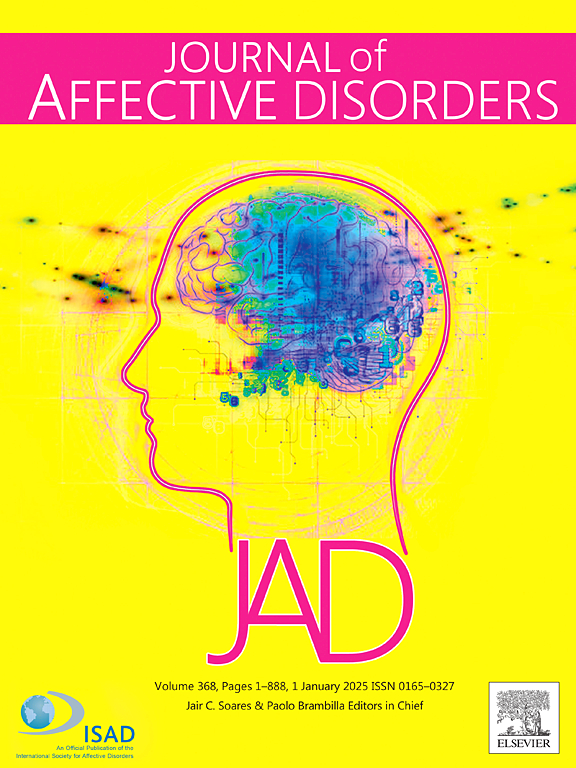Heterogeneity of depressive mood and its influences on adolescents: A latent profile analysis
IF 4.9
2区 医学
Q1 CLINICAL NEUROLOGY
引用次数: 0
Abstract
Objective
This study aims to delve into the classification of depressive mood states among adolescents and their associations with taste preferences and social jet lag.
Methods
A convenience sampling method was employed, involving all students from four middle schools in Meishan City, Sichuan Province, China. Adolescents' taste preferences were assessed using a self-reported questionnaire. Social jet lag and depressive mood were assessed using the Munich Sleep Chronotype Questionnaire and the Center for Epidemiologic Studies Depression Scale, respectively.
Results
The study analyzed 5236 adolescents, categorizing their depressive mood into four groups: Group 4: severe depressive mood (5.77 %), Group 3: mild depressive mood-low interpersonal problems (12.36 %), Group 2: mild depressive mood-high interpersonal problems (10.85 %), and Group 1: healthy (71.03 %). Gender significantly predicted the latent categories of adolescent depressive mood, with males less likely to be in Groups 3 and 4. Compared to adolescents without specific taste preferences, those preferring spicy flavors had a higher probability of being in Group 3. Adolescents preferring sweet, sour, and salty flavors were more likely to be in Groups 2, 3, and 4. Notably, adolescents preferring bitter flavors exhibited a higher likelihood of being in Groups 3 and 4. Additionally, adolescents with social jet lag <2 h were less likely to be in Groups 2, 3, and 4.
Conclusion
The study reveals substantial intergroup heterogeneity and intragroup variability in adolescent depressive mood. Female adolescents, those with specific taste preferences, and those with larger social jet lag exhibit more severe depressive mood.
青少年抑郁情绪的异质性及其影响:潜在剖面分析。
目的:探讨青少年抑郁情绪状态的分类及其与味觉偏好和社交时差的关系。方法:采用方便抽样方法,对四川省眉山市4所中学的学生进行调查。青少年的口味偏好通过自我报告问卷进行评估。社交时差和抑郁情绪分别使用慕尼黑睡眠时型问卷和流行病学研究中心抑郁量表进行评估。结果:5236名青少年的抑郁情绪分为4组:第4组:重度抑郁情绪(5.77 %),第3组:轻度抑郁情绪-低人际关系问题(12.36 %),第2组:轻度抑郁情绪-高人际关系问题(10.85 %),第1组:健康(71.03 %)。性别显著地预测了青少年抑郁情绪的潜在类别,男性不太可能出现在第3组和第4组。与没有特定口味偏好的青少年相比,那些喜欢辛辣口味的青少年更有可能被分到第三组。喜欢甜、酸、咸口味的青少年更有可能被分为第二、三、四组。值得注意的是,喜欢苦味的青少年更有可能被分为第三组和第四组。结论:本研究揭示了青少年抑郁情绪的组间异质性和组内变异性。女性青少年、有特殊口味偏好的青少年和社交时差较大的青少年表现出更严重的抑郁情绪。
本文章由计算机程序翻译,如有差异,请以英文原文为准。
求助全文
约1分钟内获得全文
求助全文
来源期刊

Journal of affective disorders
医学-精神病学
CiteScore
10.90
自引率
6.10%
发文量
1319
审稿时长
9.3 weeks
期刊介绍:
The Journal of Affective Disorders publishes papers concerned with affective disorders in the widest sense: depression, mania, mood spectrum, emotions and personality, anxiety and stress. It is interdisciplinary and aims to bring together different approaches for a diverse readership. Top quality papers will be accepted dealing with any aspect of affective disorders, including neuroimaging, cognitive neurosciences, genetics, molecular biology, experimental and clinical neurosciences, pharmacology, neuroimmunoendocrinology, intervention and treatment trials.
 求助内容:
求助内容: 应助结果提醒方式:
应助结果提醒方式:


